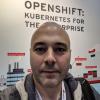In our third and final installment (see: part one & part two), let’s take a look at some high-level use cases for Linux containers as well as finally (finally) defending what I like to call “pet” containers. From a general perspective, we see three repeated high-level use cases for containerizing applications:
- The fully orchestrated, multi-container application as you would create in OpenShift via the Red Hat Container Development Kit;
- Loosely orchestrated containers that don't use advanced features like application templates and Kubernetes; and
- Pet containers.
| FULLY ORCHESTRATED MULTI-CONTAINER APPLICATION | LOOSELY ORCHESTRATED CONTAINER APPLICATION | PET CONTAINER |
|
|
|
While the best approach to take may be a fully orchestrated one, 10 years of virtualization experience (read: of trial-and-error) teach us that many IT teams will implement a combination of all three. Note that this isn’t a bad thing: the truth is that the model enabled by the Docker project has significant advantages for users, even if you don't use the aggregate packaging part.
A key feature of Linux containers is to provide namespace isolation, enabling you to run content from different generations moving at different speeds without interference in the binary runtime. From Red Hat’s perspective, the goal was (and still is) to use this as a path for structuring the Red Hat Enterprise Linux userspace and addressing the cost of migrating whole software stacks, a drive that started during the inception of the now-venerable Red Hat Enterprise Linux 5.
It is important to note, however, that this isolation does not replace component level packaging - we still create RPMs to build into the container image, although it's now easier to mix this with native upstream packages such as Ruby Gems or NPMs. So what the Docker project does is remove the single dependency on RPM - suddenly, it is viable to use native package formats where applicable or even copy-in files, if you are using it as binary packaging at the stack level.
Consider this from a historic point of view: the basic idea for Red Hat’s Linux container work started as "why can't we run Red Hat Enterprise Linux 3 code in a chroot on Red Hat Enterprise Linux 5 instead of doing this crazy kernel backport?” The answer from engineering back then was "wait until we have namespaces". The emergence of early virtualization helped manage this pain for some time, but people now find that with the growing complexity of the userspace stack, virtualization-only solutions can be rather untenable.
For example, if I want to backup my Red Hat Enterprise Linux 6 instance on KVM, I have to have a Red Hat Enterprise Linux 6 version of my backup-agent. If I want my Unison sync between my Fedora laptop and my Red Hat Enterprise Linux 6 server to work after OCAML changed the serialization format, creating a compatibility dependency on the compiler version used, I have to somehow get a whole library stack mixed between the two operating systems which, in practical terms, is impossible. With a container, either as a hybrid (desktop is not containerized, but Unison is running on a Red Hat Enterprise Linux 6 containers) or fully containerized, these issues can be solved, reducing them to kernel syscall, filesystem layout and sometimes API dependencies.
In many cases, these will be “pet containers” - instances where the respective docker image is simply used as a way to bootstrap an environment and then treat it like a traditional deployment, running yum (or dnf) inside. That is a totally valid use case, with only a minimal threshold between using a pet container and building a container with a build service. There is work to do to actually enable this model, but the difference between pets and using build is quite small, unless you expect to directly operate on the host - which involves a path change (chroot /host).
So why defend the pet container if the other models are actually “better” use cases for container deployments? It’s all about easing barriers to adoption - deploying via a build service, while not particularly taxing, doesn’t necessarily mesh with the workflows of existing enterprises, including Red Hat customers. By embracing the concept of pet containers, we can better enable our customers to move existing applications into containers, effectively providing a Red Hat Enterprise Linux 6 userspace environment on Red Hat Enterprise Linux 7. This can drive adoption without forcing wholesale operational change - a key motivator in encouraging innovation at the customer level and, hopefully, the enterprise IT world at large.
To try this, the no-cost Red Hat Developer Subscription and the Red Hat Container Development Kit are excellent entry points. Questions or feedback? Reach out using the comments section (below).
執筆者紹介
Daniel Riek is responsible for driving the technology strategy and facilitating the adoption of Analytics, Machine Learning, and Artificial Intelligence across Red Hat. Focus areas are OpenShift / Kubernetes as a platform for AI, application of AI development and quality process, AI enhanced Operations, enablement for Intelligent Apps.
類似検索
Slash VM provisioning time on Red Hat Openshift Virtualization using Red Hat Ansible Automation Platform
Red Hat Ansible Automation Platform: Measuring Business Impact with Dashboard and Analytics
Technically Speaking | Platform engineering for AI agents
Technically Speaking | Driving healthcare discoveries with AI
チャンネル別に見る
自動化
テクノロジー、チームおよび環境に関する IT 自動化の最新情報
AI (人工知能)
お客様が AI ワークロードをどこでも自由に実行することを可能にするプラットフォームについてのアップデート
オープン・ハイブリッドクラウド
ハイブリッドクラウドで柔軟に未来を築く方法をご確認ください。
セキュリティ
環境やテクノロジー全体に及ぶリスクを軽減する方法に関する最新情報
エッジコンピューティング
エッジでの運用を単純化するプラットフォームのアップデート
インフラストラクチャ
世界有数のエンタープライズ向け Linux プラットフォームの最新情報
アプリケーション
アプリケーションの最も困難な課題に対する Red Hat ソリューションの詳細
仮想化
オンプレミスまたは複数クラウドでのワークロードに対応するエンタープライズ仮想化の将来についてご覧ください
